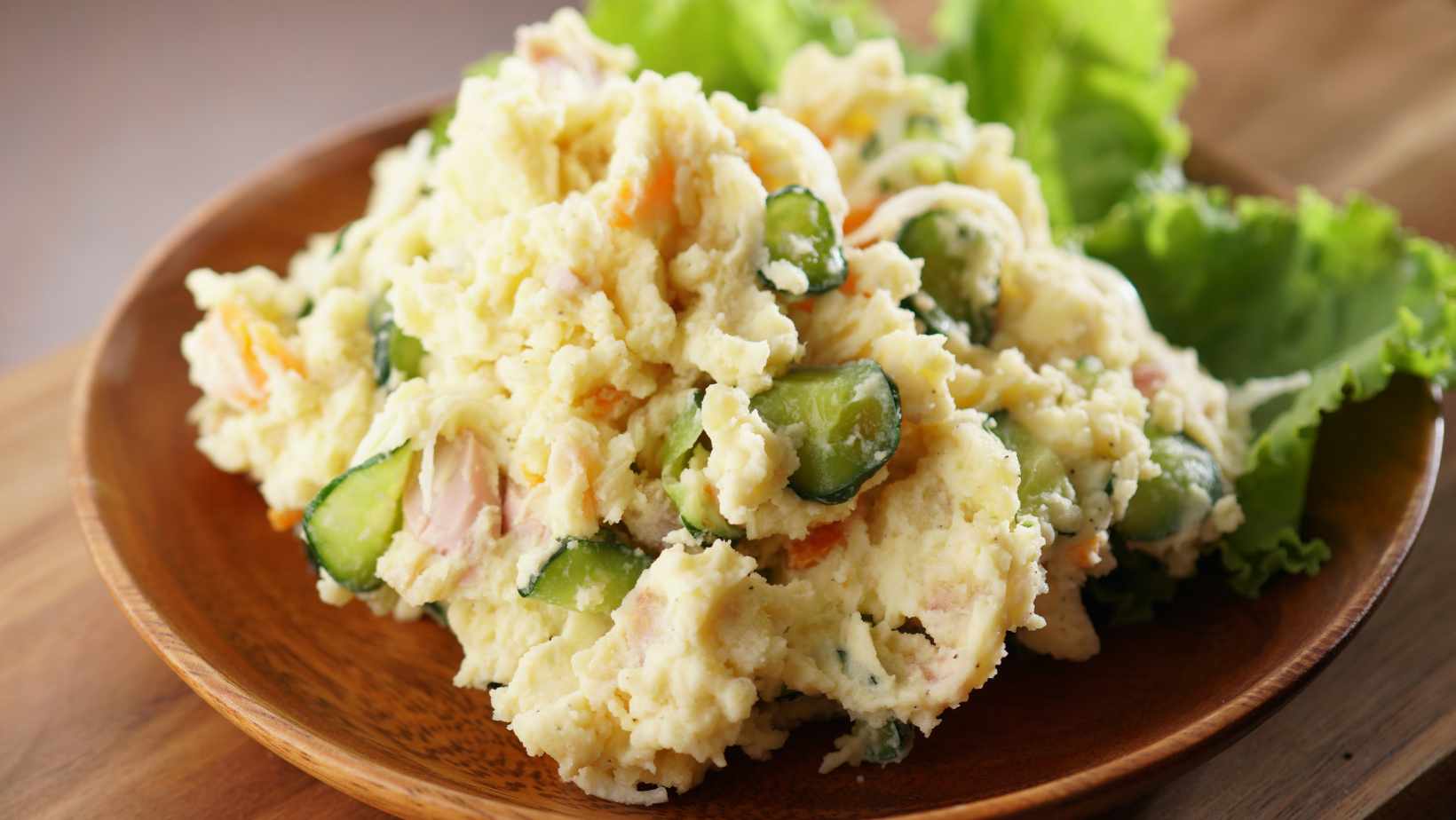
To understand the nutritional value of potato salad with its ingredients, examine the benefits of each component. First, let’s introduce you to Potato Salad. It is a delicious side dish made of potatoes and several other ingredients. Second, let’s investigate the benefits of potatoes, packed full of potassium and Vitamin C. Lastly, we will delve into the nutritional benefits of other ingredients in Potato Salad that are just as important.
How Many Carbs in Potato Salad
Potatoes offer amazing nutrition – potassium, vitamin C, and more. To make a healthier potato salad, opt for a mustard-based dressing in place of mayonnaise. Also, adding vegetables like celery or carrots will increase fibre content. Experiment with different ingredients to find what works for you. You can serve it cold or warm. Get creative and make your own delicious, nutritious version of the popular dish. Enjoy the nutritional jackpot of potato salad!
Nutritional Benefits of Potatoes
Potatoes possess an abundance of nutrients that benefit overall health. These tubers are a staple in many diets and meet daily dietary needs.
- Potatoes provide carbs, fibre, and protein which provide energy and keep hunger levels at bay.
- They contain vitamins like C, B6, and A that help with immunity, energy, and healthy skin.
- One serving of potatoes gives 18% of the daily potassium needed for muscle movement.
- The antioxidants in colourful potatoes help reduce inflammation and improve heart health.
- Resistant starch in cooked potatoes supports gut bacteria and reduces colon cancer risk.
Consuming different types like sweet and purple potatoes has extra health benefits. But moderation is key; too much can lead to weight gain and high blood sugar.
Penn State researchers studied potato salad, finding that chilled boiled or steamed potato salad with added vinegar dressing helps reduce post-meal blood sugar levels.
Potato salad is a great way to get vitamin C from potatoes, protein from eggs, and crunchy veggies for fibre.
Nutritional Benefits of other Ingredients in Potato Salad
Potato Salad – A Nutritional Delight!
Each ingredient in potato salad brings its own nutritional benefits. Mayonnaise adds essential fatty acids and Vitamin E. Celery is rich in fibre, antioxidants, and minerals. Pickles offer probiotics to help digestion and boost immunity. Onions are a good source of Vitamin C, B6, and antioxidants. Eggs give high protein content which helps bodybuilding, plus selenium to control thyroid function and preserve vision.
Plus, you can add carrots or cucumbers to get extra nutrients not found in other ingredients. But, be sure to eat potato salad within two hours of preparing, or else it could cause food poisoning.
Nutrition doesn’t just come from one ingredient. Every component brings something unique! Counting carbs in potato salad is impossible – and I don’t want to know the answer anyway!
How Many Carbs are in Potato Salad?
To determine how many carbs are in potato salad, you need to understand their importance in the dish’s nutritional value. In order to calculate the carbs in potato salad accurately, you need to be aware of the right methods. This section will provide you with examples of carbs in different potato salad recipes so you can make informed decisions about the nutritional content of your meals.
Why Carbs are Important in Potato Salad
Potato salad is a popular dish. Its nutrient composition matters, as it contains carbs which provide energy and help maintain blood sugar levels. Complex carbs take time to digest, making potato salad a great meal for those looking to reduce calorie intake.
Carb content depends on the ingredients and preparation. Common ingredients like potatoes, mayonnaise, mustard, vinegar, and sugar have varying carb amounts. Mustard and vinegar are low-carb, while mayo has more due to oil-based ingredients. A 1-cup portion could have 20-40g of carbs.
Carbs help with brain functioning, as they are a primary macronutrient for our brains. Eating moderate amounts of carbs in foods like potato salad can help maintain cognitive integrity.
USDA Nutrient Database states that 100g of boiled potatoes have 87 calories, and provide 20% Vitamin C and 13% dietary fibre. Potatoes have been ranked third by Harvard Medical School’s Healthy Eating Plate for health benefits when consumed regularly – despite the high carb content.
How to Calculate Carbs in Potato Salad
Calculating carb content in potato salad can be tough. But the right approach makes it doable. To get an accurate carb amount, consider serving size and ingredients. Create a table – columns like ingredients, quantity, total carbs, and serving size.
For example, 100g of potatoes contain 16g carbs and a tablespoon of mayo has 1-2g carbs. Keep in mind, some ingredients may have hidden carbs. Different potatoes have different carb levels. White potatoes contain more than sweet potatoes. For fewer carbs, try light mayo or Greek yoghurt instead of regular mayo. Get ready to count carbs like sheep in your sleep with these tasty potato salad recipes!

Examples of Carbs in Different Potato Salad Recipes
Potato salads are famous for their carbs. But just how much?
More ingredients means more carbs. Plus, recipes with more fat could raise overall calorie intake.
One individual said that low-carb dieting helped their health and lowered inflammation. But then they missed eating potato salad! So they found a parsley pesto recipe that had lower carbs and still tasted great.
All that carb content, but hey, there’s some Vitamin C in there too!
Other Nutritional Information about Potato Salad
To get a full understanding of the nutritional value in potato salad, you need to look at some other key factors. In order to explore the topic of “Other Nutritional Information about Potato Salad” with a focus on “Protein Content in Potato Salad, Fiber Content in Potato Salad and Fat Content in Potato Salad”.
Protein Content in Potato Salad
Potato salad is a favourite side dish of many. Sadly, it only contains 3 grams of protein per serving. If you want to increase the protein content, there are plenty of ingredients to add. Check out the table below for examples.
| Ingredient | Protein Content |
| Hard-boiled eggs | 13 g |
| Grilled chicken | 31 g |
| Canned tuna | 30 g |
| Greek yoghourt | 10 g |
For plant-based options, try chickpeas or black beans. You can also use vegan mayo instead of traditional.

Plus, potato salad provides essential nutrients like fibre and potassium. Fibre is good for digestion, and potassium regulates blood pressure and guards against heart disease.
If you’re creative, why not replace potatoes with sweet potatoes? The result is a delicious, sweet-savoury mix, plus all the nutrition of sweet potatoes!So, to get some fibre in your diet, just add potato salad!
Fibre Content in Potato Salad
Potato salad is a popular dish, yet many people question its nutritional value. We’ll look at the dietary fibre amount in ‘Potato Salad’.
A simple table shows the ingredients of a traditional potato salad and their dietary fibre per 100g serving size.
| Ingredients | Dietary Fibre per 100g |
| Potatoes | 2g |
| Eggs | 0g |
| Mayo | 0.4g |
| Onions | 1.7g |
So, potatoes and onions are the primary sources of dietary fibre in potato salad.
Adding celery or carrots or red peppers will increase the fibre. Plus, these veggies bring extra nutrients like vitamin C.
For an extra boost, use homemade dressings. They have less sugar, fewer calories, and more heart-healthy fats.
However, potato salad can be a nightmare for your arteries as it contains high fat content.
Fat Content in Potato Salad
Potato salad is a popular side dish. But, how does the fat content compare to other dishes? Let’s look at the nutritional info.
One cup of potato salad has 19g of fat. This could vary depending on the recipe and ingredients used.
Potato salad is high in fat. But, it also has carbs, which can be good for active people. Be aware that some ingredients can add calories and salt. For example, mayonnaise or bacon bits. Try healthier alternatives like Greek yoghurt or chicken breast instead.
Is potato salad healthy? It depends on the mayo and the strength of your butt-clenching!
Conclusion: Is Potato Salad a Healthy Option?
To conclude the nutritional value of potato salad and determine whether it is a healthy option, turn to the sub-sections for solutions. Gain insights from the summary of nutritional values, recommendations for consumption, and the potential weight management benefits of consuming potato salad.
Summary of Nutritional Value of Potato Salad
Potato salad – a healthy option when made with the right ingredients. Analyse its nutritious value here!
Nutrients:
- Calories – 143
- Carbohydrates – 21g
- Protein – 2.5g
- Fat – 5g
- Fibre – 2g
Potato salad is a great source of carbs, giving you the energy you need for daily activities. Plus, it has fibre to help with digestion and absorbing nutrients.
Make it even healthier! Use low-fat/fat-free mayo instead of full-fat for fewer calories. Add spinach, kale, and colourful peppers to get in vitamins and minerals, plus antioxidants for overall body health.
Potato salad: scoop in the mayo and enjoy!
Recommendations for Potato Salad Consumption
Guidelines for Eating Potato Salad
For a healthy diet, it’s important to consider how much potato salad you eat. Here are some tips:
- Portion control is key.
- Choose salads with healthier ingredients like grilled chicken, veggies and herbs.
- Use low-fat or Greek yoghourt instead of high-fat mayo.
- Steer clear of heavily processed types with high-sugar dressings.
- Check the nutritional value and read labels if available.
Be aware that not all variations are healthy. Avoid those with lots of fat and sugar.
Potato salad is a popular American dish, especially at summer barbecues. Who needs a personal trainer? Potato salad can help you watch your weight.
Potential Weight Management Benefits of Consuming Potato Salad.
Potato salad can be great for weight management. Here are three reasons why:
- Fibre packed: Potato salad has fibre-rich ingredients like potatoes, veggies and legumes. These help to make you feel satisfied and stop you from overeating.
- Low calories: By using low-fat dressings and cutting out high-calorie ingredients such as bacon, the calorie count goes down, without compromising on taste.
- Nutritious: Adding a variety of colourful vegetables makes potato salad a nutritious meal that can supplement other healthy meals.
Potato salad can also help with digestion and immunity. But not all potato salads are the same. Heavy dressings and fried add-ins can harm health goals.
Someone once tried using cauliflower instead of potatoes for their potato salad. It was lower in carbs and calories, plus added extra veggies! Delicious!
